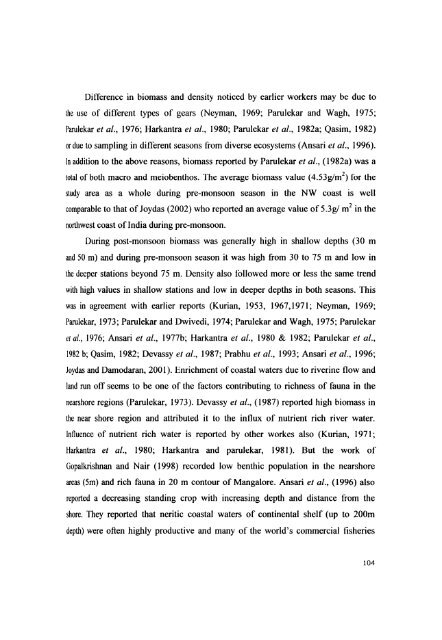L - Cochin University of Science and Technology
L - Cochin University of Science and Technology
L - Cochin University of Science and Technology
Create successful ePaper yourself
Turn your PDF publications into a flip-book with our unique Google optimized e-Paper software.
Difference in biomass <strong>and</strong> density noticed by earlier workers may be due to<br />
the use <strong>of</strong> different types <strong>of</strong> gears (Neyman, 1969; Parulekar <strong>and</strong> Wagh, 1975;<br />
Parulekar et al., 1976; Harkantra et al., 1980; Parulekar et al., 1982a; Qasim, 1982)<br />
or due to sampling in different seasons from diverse ecosystems (Ansari et al., 1996).<br />
In addition to the above reasons, biomass reported by Parulekar et al., (1982a) was a<br />
total <strong>of</strong> both macro <strong>and</strong> meiobenthos. The average biomass value (4.53g1m 2 ) for the<br />
study area as a whole during pre-monsoon season in the NW coast is well<br />
comparable to that <strong>of</strong> Joydas (2002) who reported an average value <strong>of</strong> 5.3g1 m 2 in the<br />
northwest coast <strong>of</strong> India during pre-monsoon.<br />
During post-monsoon biomass was generally high in shallow depths (30 m<br />
<strong>and</strong> 50 rn) <strong>and</strong> during pre-monsoon season it was high from 30 to 75 m <strong>and</strong> low in<br />
the deeper stations beyond 75 m. Density also followed more or less the same trend<br />
with high values in shallow stations <strong>and</strong> low in deeper depths in both seasons. This<br />
was in agreement with earlier reports (Kurian, 1953, 1967,1971; Neyman, 1969;<br />
Parulekar, 1973; Parulekar <strong>and</strong> Dwivedi, 1974; Parulekar <strong>and</strong> Wagh, 1975; Parulekar<br />
et al., 1976; Ansari et al., 1977b; Harkantra et al., 1980 & 1982; Parulekar et al.,<br />
1982 b; Qasim, 1982; Devassy et al., 1987; Prabhu et al., 1993; Ansari et aI., 1996;<br />
Joydas <strong>and</strong> Damodaran, 2001). Enrichment <strong>of</strong> coastal waters due to riverine flow <strong>and</strong><br />
l<strong>and</strong> run <strong>of</strong>f seems to be one <strong>of</strong> the factors contributing to richness <strong>of</strong> fauna in the<br />
nearshore regions (Parulekar, 1973). Devassy et al., (1987) reported high biomass in<br />
the near shore region <strong>and</strong> attributed it to the influx <strong>of</strong> nutrient rich river water.<br />
Influence <strong>of</strong> nutrient rich water is reported by other workes also (Kurian, 1971;<br />
Harkantra et al., 1980; Harkantra <strong>and</strong> parulekar, 1981 ). But the work <strong>of</strong><br />
Gopalkrishnan <strong>and</strong> Nair (1998) recorded low benthic population in the nearshore<br />
areas (Srn) <strong>and</strong> rich fauna in 20 m contour <strong>of</strong> Mangalore. Ansari et al., (1996) also<br />
reported a decreasing st<strong>and</strong>ing crop with increasing depth <strong>and</strong> distance from the<br />
shore. They reported that neritic coastal waters <strong>of</strong> continental shelf (up to 200m<br />
depth) were <strong>of</strong>ten highly productive <strong>and</strong> many <strong>of</strong> the world's commercial fisheries<br />
104

















